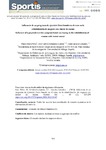Influencia de un programa de ejercicio físico basado en el remo en la rehabilitación de mujeres con cáncer de mama

Use este enlace para citar
http://hdl.handle.net/2183/39074
Excepto si se señala otra cosa, la licencia del ítem se describe como Atribución-NoComercial-CompartirIgual 3.0 España
Colecciones
Metadatos
Mostrar el registro completo del ítemTítulo
Influencia de un programa de ejercicio físico basado en el remo en la rehabilitación de mujeres con cáncer de mamaTítulo(s) alternativo(s)
Influence of a physical exercise program based on rowing in the rehabilitation of women with breast cancerFecha
2024-05-01Cita bibliográfica
Real Pérez, M; Fernández-García, J.C.; Gavala-González, J. (2024). Influencia de un programa de ejercicio físico basado en el remo en la rehabilitación de mujeres con cáncer de mama. Sportis Sci J, 10 (2), 283-299 https://doi.org/10.17979/sportis.2024.10.2.10347
Resumen
[Resumen]
En el siguiente estudio longitudinal, analizamos la influencia del remo en banco móvil con embarcaciones de remo de mar sobre la antropometría y la condición física de remeras supervivientes de cáncer de mama (n=20; 57.20 ± 6.38 años). Para ello, se llevaron a cabo dos sesiones/ semana de 75 minutos de duración durante 24 semanas y se compararon los resultados obtenidos en test antropométricos y de condición física antes y después del programa de entrenamiento. Los resultados obtenidos indican una mejora estadísticamente significativa tanto en los parámetros antropométricos: peso (-1.75 kg), índice de masa corporal (-.67 kg/m2), perímetro de cintura (-3.66 cm) y de cadera (-2.87 cm); como en las variables de condición física: capacidad aeróbica (93.65 m); flexibilidad general (4.4 cm); flexibilidad del miembro superior dominante (1.44 cm) y no dominante (1.5 cm); y la fuerza muscular del miembro inferior (3.1 cm) y superior, tanto del brazo dominante (4.34 kgf), como del no dominante (3.32 kgf). Por ello, podemos concluir que un programa desarrollado en embarcaciones de remo de mar puede ser una estrategia eficaz en la rehabilitación de mujeres supervivientes de cáncer de mama, mejorando su capacidad física y antropometría, lo que podría reportar beneficios sobre su estado de salud y calidad de vida. [Abstract]
In the following longitudinal study, we examined the influence of mobile bench rowing with sea rowing boats on the anthropometry and physical condition of breast cancer survivor rowers (n=20; 57.20 ± 6.38 years). To do this, two sessions per week lasting 60 to 90 minutes were conducted for 24 weeks, and the results of anthropometric and physical condition tests were compared before and after the training program. The obtained results indicate a statistically significant improvement in both anthropometric parameters: weight (-1.75 kg), body mass index (-0.67 kg/m2), waist circumference (-3.66 cm), and hip circumference (-2.87 cm); as well as in physical condition variables: aerobic capacity (93.65 m); general flexibility (4.4 cm); flexibility of the dominant upper limb (1.44 cm) and non-dominant (1.5 cm); and muscle strength of the lower limb (3.1 cm) and upper limb, both in the dominant arm (4.34 kgf) and the non-dominant arm (3.32 kgf). Therefore, we can conclude that a program based on sea rowing boats can be an effective strategy in the rehabilitation of breast cancer survivor women, improving their physical capacity and anthropometry, which could result in health and quality of life benefits.
Palabras clave
Remo
Banco móvil
Cáncer de mama
Antropometría
Condición física
Rowing
Sliding seat rowing
Breast cancer
Anthropometry
Physical condition
Banco móvil
Cáncer de mama
Antropometría
Condición física
Rowing
Sliding seat rowing
Breast cancer
Anthropometry
Physical condition
Versión del editor
Derechos
Atribución-NoComercial-CompartirIgual 3.0 España
ISSN
2386-8333






